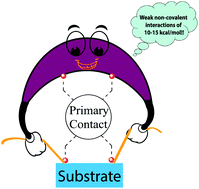A quantification scheme for non-covalent interactions in the enantio-controlling transition states in asymmetric catalysis†
Abstract
The origin of enantioselectivity in asymmetric catalysis is attributed to the energy difference between lower and higher energy diastereomeric transition states, which are respectively responsible for the formation of major and minor enantiomers. Although the increase in the number of transition state models emphasizes the role of weak non-covalent interactions in asymmetric induction, the strength of such interactions is seldom quantified. Through this article, we propose a simple and effective method of quantifying the total non-covalent interaction in stereocontrolling transition states belonging to a group of three representative asymmetric catalytic reactions involving chiral phosphoric acids. Our method relies on rational partitioning of a given transition state into two (or three) sub-units, such that the complex network of intramolecular interactions can be ameliorated to a set of intermolecular interactions between two sub-units. The computed strength of interaction obtained using the counterpoise (CP) method on suitably partitioned transition states provides improved estimates of non-covalent interactions, which are also devoid of basis set superposition error (BSSE). It has been noted that catalysts decorated with larger aromatic arms provide cumulative non-covalent interactions (C–H⋯π, N–H⋯π and π⋯π) to the tune of 10 to 15 kcal mol−1. Fine-tuning of the magnitude and nature of these interactions can provide valuable avenues in the design of asymmetric catalysts.

- This article is part of the themed collection: Celebrating the RAOBC symposium


 Please wait while we load your content...
Please wait while we load your content...